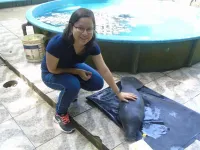(Press-News.org) Chemotherapy can induce a painful peripheral neuropathy (CIPN), a chronic condition and common adverse effect for cancer patients undergoing treatment. Researchers at University of California San Diego School of Medicine, with colleagues elsewhere, have used a mouse model to demonstrate the pivotal role of cholesterol in CIPN, and proposed a novel therapeutic approach to reverse it.
The findings are published in the May 10, 2021, online issue of the Journal of Experimental Medicine.
The study was a collaboration between the laboratories of senior study author Yury Miller, MD, PhD, professor of medicine, and Tony Yaksh, PhD, professor of anesthesiology and pharmacology, both at UC San Diego School of Medicine. Miller studies cholesterol metabolism and cardiovascular and neuro inflammation. Yaksh specializes in neuropathic pain.
"It was truly gratifying to work at the intersection of two disciplines and identify the role cholesterol plays in activation of microglia -- immune cells of the spinal cord -- and regulation of chronic pain," said first author Juliana Navia-Pelaez, PhD, a postdoctoral fellow in Miller's lab.
"The metabolism of cellular cholesterol was already linked to neurological conditions, such as Alzheimer's disease, but we were first to show its role and underlying mechanisms in chronic pain."
Cholesterol is essential for brain function, both during development and in adult life. It is a major component of cell membranes, a precursor to some hormones and serves as a cellular messenger. However, excess of cholesterol is detrimental to human health; buildup of cholesterol plaques in large arteries often causes heart attacks and stroke.
The UC San Diego team found that changes in cholesterol metabolism contributed to reprogramming of microglia in a way that perpetuated chronic inflammation in the spinal cord. Genetically modified mice lacking cholesterol transporters in microglia were unable to remove excessive amounts of cholesterol, and thus experienced pain -- even without chemotherapeutic intervention.
The outer membrane of these cells, which is normally fluid, became rigid with accumulated cholesterol in the form of floating solid platforms called lipid rafts. The lipid raft environment, said the authors, favors assembly and activation of cellular proteins that mediate inflammatory response, such as Toll-like receptor-4 (TLR4).
"We were surprised to find that in CIPN, enlarged lipid rafts and TLR4 assemblies persisted for days and weeks," said Miller. "We even started calling them 'inflammarafts' to stress the importance of these membrane domains in neuroinflammation and pain states."
To reverse the harmful effects of excessive cholesterol in microglia, researchers used a modified version of the apoA-I binding protein (AIBP), which hastens cholesterol removal and disrupts inflammarafts, but does not damage physiological lipid rafts. A single injection of AIBP in the spinal canal of mice reversed CIPN pain, and the therapeutic effect lasted for several weeks, without adverse effects.
"The long-lasting effect we observed with the delivery of AIBP points to a reprogramming of these immune cells that implies cholesterol plays a fundamental role in gene expression," said Navia-Pelaez. "It might even act as a driver of epigenetic alterations in microglia and ultimately pain behavior."
The authors said the results are part of a promising series of investigations, conducted by UC San Diego and Raft Pharmaceuticals.
"Considerable work remains to be done in terms of safety and kinetics to move this new biologic ahead for clinical trials," said Yaksh, "but the present results are exceedingly promising as they provide a hitherto unappreciated target -- inflammarafts in immune cells -- for drug development in the management of chronic neuropathic pain."
INFORMATION:
Co-authors include: Soo-Ho Choi, Luciano dos Santos Aggum Capettini, Yining Xia, Ayelet Gonen, Colin Agatia-Boyle, Jungsu Kim, Jenny W. Lu, Benjamin Saylor, Lauriane Delay, Gilson Goncalves dos Santos, Glaucilene Ferreira Catroli, Maripat Corr and Irina Kufareva, UC San Diego; Holger Winkels, Christopher P. Durant, Yanal Ghosheh and Klaus Ley, La Jolla Institute for Immunology; and Graham Beaton, Raft Pharmaceuticals.
Disclosure: Yury Miller and Tony Yaksh hold equity in Raft Pharmaceuticals.
Full study: https://rupress.org/jem/article/218/7/e20202059/212084/Normalization-of-cholesterol-metabolism-in-spinal
Evidence of recent volcanic activity on Mars shows that eruptions could have taken place in the past 50,000 years, according to new study by researchers at the University of Arizona's Lunar and Planetary Laboratory and the Planetary Science Institute.
Most volcanism on the Red Planet occurred between 3 and 4 billion years ago, with smaller eruptions in isolated locations continuing perhaps as recently as 3 million years ago. But, until now, there was no evidence to indicate Mars could still be volcanically active.
Using data from satellites orbiting Mars, researchers discovered a previously unknown volcanic ...
All three species of manatee now present on Earth share a common ancestor from which they split some 6.5 million years ago, when a huge lake in Amazonia, then linked to the Caribbean, was cut off from the sea. The African manatee Trichechus senegalensis is not as genetically close to the West Indian manatee T. manatus as was thought, and adaptation to this complex environment by the Amazonian manatee T. inunguis has left at least one mark in its genetic code.
These are key findings of a study supported by FAPESP and published in Scientific Reports, with hitherto unknown details of the evolutionary history of these aquatic mammals. The authors are an international group of scientists led by researchers at the University of Campinas ...
The American College of Chest Physicians® (CHEST) recently released new clinical guidelines on the Diagnosis and Evaluation of Hypersensitivity Pneumonitis (HP). The guidelines contain 14 evidence-based recommendations to improve individual diagnostic decision-making and to decrease diagnostic practice variability.
Occurring at any age, HP is an immunologically mediated form of lung disease resulting from inhalational exposure to a large variety of environmental and/or occupational inciting antigens (typically fungal, bacterial, avian). Over the years, the categorization of HP based on clinical features and disease duration coupled with traditional diagnostic criteria has been unhelpful, even when accurate, when separated from a probabilistic diagnostic ...
Clavelina oblonga, an invasive marine fouling species, not only reduces diversity in communities it invades, it also interferes in their recovery following natural disasters - a process known as "succession."
Succession refers to how an ecosystem recovers after a disturbance or natural disaster - does the system come back more or less the same as it was in terms of species composition, or is it different?
"The classic example of succession is a forest that experiences a wildfire," says Kayla Christianson, former NC State graduate student and first author of a paper describing the research. "As the community recovers from the fire, it proceeds through a predictable pattern of community development - starting with grasses and ending with trees and a mature forest. This ...
Since it debuted in 2011, the Get SET Early program, which provides pediatricians and parents with a relatively simple process to screen for indicators of autism spectrum disorder (ASD) in children as young as age 1, has steadily grown in use and validation. Early screening and identification of ASD has been linked to more effective treatment.
A new study, published in the April 26, 2021 issue of the END ...
PHILADELPHIA-- Human brain organoids are remarkable platforms for modeling features of human brain development and diseases. Building on methods to generate organoids to model different brain regions such as the cortex and the midbrain, researchers at the Perelman School of Medicine at the University of Pennsylvania have generated the first organoids of the arcuate nucleus (ARC), an essential structure in the hypothalamus that sends signals of hunger and feeling full. This part of the hypothalamus exhibits a tremendous amount of cell diversity, and is far more complex than previously modeled parts of the brain.
In a paper ...
Scientists have made major advances in understanding and developing treatments for many cancers by identifying genetic mutations that drive the disease. Now a team led by researchers at Weill Cornell Medicine, NewYork-Presbyterian and the New York Genome Center (NYGC) has developed a machine learning technique for detecting other modifications to DNA that have a similar effect.
The study, published May 10 in Cancer Discovery, a journal of the American Association for Cancer Research, focuses on a type of chemical modification to DNA, called methylation, that typically silences nearby genes. The new technique can analyze the thousands of DNA methylation changes detected in tumor cells and infer which ones are likely ...
HOUSTON - Researchers at The University of Texas MD Anderson Cancer Center have developed a first-of-its-kind spatial atlas of early-stage lung cancer and surrounding normal lung tissue at single-cell resolution, providing a valuable resource for studying tumor development and identifying new therapeutic targets. The study was published today in Cancer Discovery, a journal of the American Association for Cancer Research.
The findings reveal a heterogeneous lung cancer ecosystem, with extensive interactions between cancer cells and the surrounding microenvironment that regulate early cancer development. ...
New research on the growth rates of coral reefs shows there is still a window of opportunity to save the world's coral reefs--but time is running out.
The international study was initiated at the ARC Centre of Excellence for Coral Reef Studies (Coral CoE), which is headquartered at James Cook University (JCU).
Co-author Professor Morgan Pratchett from Coral CoE at JCU said the results show that unless carbon dioxide emissions are drastically reduced the growth of coral reefs will be stunted.
"The threat posed by climate change to coral reefs is already very apparent based on recurrent episodes of mass coral bleaching," Prof Pratchett said. "But changing environmental conditions will have other far-reaching consequences."
Co-author Professor Ryan Lowe, from Coral CoE at The University ...
A new study looking at the evolutionary history of the human oral microbiome shows that Neanderthals and ancient humans adapted to eating starch-rich foods as far back as 100,000 years ago, which is much earlier than previously thought.
The findings suggest such foods became important in the human diet well before the introduction of farming and even before the evolution of modern humans. And while these early humans probably didn't realize it, the benefits of bringing the foods into their diet likely helped pave the way for the expansion of the human brain because of the glucose in starch, which is the brain's main fuel source.
"We think we're seeing evidence of a really ...





